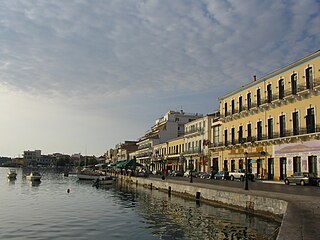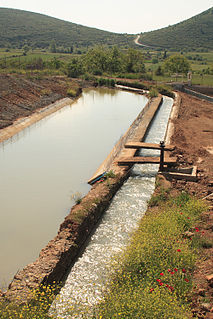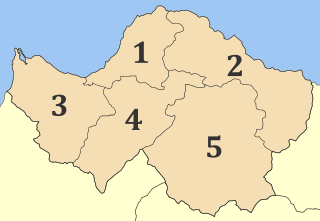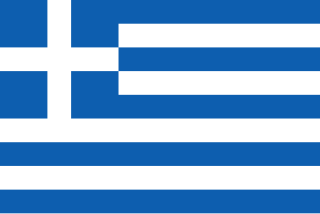Asopus is the name of four different rivers in Greece and one in Turkey. In Greek mythology, it was also the name of the gods of those rivers. Zeus carried off Aegina, Asopus' daughter, and Sisyphus, who had witnessed the act, told Asopus that he could reveal the identity of the person who had abducted Aegina, but in return Asopus would have to provide a perennial fountain of water at Corinth, Sisyphus' city. Accordingly, Asopus produced a fountain at Corinth, and pursued Zeus, but had to retreat for fear of Zeus' terrible thunderbolt.
Mesatis was a town of ancient Achaea, in the neighbourhood of Patrae. It is said to have been founded by the Ionians, when they were in the occupation of the country. After the expulsion of the Ionians, the Achaean hero Patreus withdrew the inhabitants from Antheia and Mesatis to Aroë, which he enlarged and called Patrae after himself. The acropolis of the city probably continued to bear the name of Aroë, which was often used as synonymous with Patrae. In the war between the Achaeans and the Romans Patrae suffered so severely, that the greater part of the inhabitants abandoned the city and took up their abodes in the surrounding villages of Mesatis, Antheia, Bolina, Argyra, and Arba.

Gytheio or Gythio, also the ancient Gythium or Gytheion, is a town on the eastern shore of the Mani Peninsula, and a former municipality in Laconia, Peloponnese, Greece. Since the 2011 local government reform it is part of the municipality East Mani, of which it is a municipal unit. The municipal unit has an area of 197.313 km2. It was the seaport of Sparta, some 40 kilometres north. Gytheio is the site of ancient Cranae, a tiny island where according to legend Paris of Troy and Helen from Sparta spent their first night together before departing for Troy, thus igniting the Trojan War.
Cleonae or Kleonai was a city in ancient Peloponnesus, described by writers of the Roman period as a city of Argolis, but never included in the Argeia or territory of Argos, in the flourishing period of Greek history. Cleonae was situated on the road from Argos to Corinth, at the distance of 120 stadia from the former city, and 80 stadia from the latter. There was a narrow pass through the mountains, called Tretus, leading from Argos to Cleonae. Cleonae stood in a small plain upon a river flowing into the Corinthian Gulf a little westward of Lechaeum. In its territory was Mount Apesas, now Mount Phoukas, connected with the Acrocorinthus by a rugged range of hills. Both Strabo and Pausanias describe Cleonae as a small place; and the former writer, who saw it from the Acrocorinthus, says that it is situated upon a hill surrounded on all sides by buildings, and well walled, so as to deserve the epithet given to it by Homer in the Catalogue of Ships in the Iliad – ἐϋκτιμένας Κλεωνάς. Statius also speaks of "ingenti turritae mole Cleonae."
In Greek mythology, Harpina was a Naiad nymph and daughter of Phliasian Asopus and of Metope. Pausanias (5.22.6) and Diodorus Siculus (4.73.1) mention Harpina and state that, according to the tradition of the Eleans and Phliasians, Ares mated with her in the city of Pisa and she bore him Oenomaus, the king of Pisa. Oenomaus (6.21.8) founded and named after his mother the city of Harpina, not far from the river Harpinates, near Olympia. Pausanias (5.22.6) mentions Harpina in his description of a group sculpture, donated by the Phliasians, of the daughters of Asopus, which included Nemea, Zeus seizing Aegina, Harpina, Corcyra, Thebe and Asopus. The sculpture was located in the sanctuary of Hippodamia at Olympia.

Orchomenus or Orchomenos was an ancient city of Arcadia, Greece, called by Thucydides the Arcadian Orchomenus, to distinguish it from the Boeotian town.
In Greek mythology, Erato was a dryad. She was the priestess and prophetess of the god Pan, verses were attributed to her at an ancient oracle of the god, located at Megalopolis near Acacesium. Erato was married to Arcas, the son of Zeus and Callisto, and bore him three sons, Azan, Apheidas, and Elatus.
In Greek mythology, Pallas was one of the Titans. According to Hesiod, he was the son of Crius and Eurybia, the brother of Astraeus and Perses, the husband of Styx, and the father of Zelus, Nike ("Victory"), Kratos, and Bia. Hyginus says that Pallas, whom he calls "the giant", also fathered with Styx: Scylla, Fontes ("Fountains") and Lacus ("Lakes"). Pallas was sometimes regarded as the Titan god of warcraft and of the springtime campaign season.
Acraea was a name that had several uses in Greek and Roman mythology.
Panopeus (Πανοπεύς), or Phanoteus, was a Greek town of ancient Phocis, near the frontier of Boeotia, and on the road from Daulis to Chaeronea. Pausanias said that Panopeus was 20 stadia from Chaeronea and 7 from Daulis; but the latter number is almost certainly a mistake. The ruins at the village of Agios Vlasios, which are clearly those of Panopeus, are about 20 stadia distant from Chaeronea, but as much as 27 stadia distant from Daulis.
Thelpusa or Thelpousa, or Telphusa or Telphousa (Τέλφουσα), was a town in the west of ancient Arcadia, situated upon the left or eastern bank of the river Ladon. Its territory was bounded on the north by that of Psophis, on the south by that of Heraea, on the west by the Eleia and Tisatis, and on the east by that of Cleitor, Tripolis, and Theisoa. The town is said to have derived its name from a nymph, the daughter of the Ladon, which nymph was probably the stream flowing through the lower part of the town into the Ladon.
In Greek mythology, Bolina or Boline (Βολίνη) was a nymph. According to Pausanias, Bolina was once a mortal maiden of Achaea. She was loved by the god Apollo, and when he attempted to approach her, Bolina fled from him and threw herself into the sea to escape his advances. Thereupon the god made her immortal. On the spot where Bolina fell into the sea, the town Bolina was founded.
Prasiae or Prasiai, or Prasia (Πρασία), also known as Brasiae or Brasiai (Βρασιαί), was a town on the eastern coast of ancient Laconia, described by Pausanias as the farthest of the Eleuthero-Laconian places on this part of the coast, and as distant 200 stadia by sea from Cyphanta. The Periplus of Pseudo-Scylax speaks of it as a city and a harbour. The name of the town was derived by the inhabitants from the noise of the waves (Βράζειν). Pausanias relates a story, found nowhere else in Greece, that Semele, after giving birth to her son by Zeus, was discovered by Cadmus and put with Dionysus into a chest, which was washed up by the waves at Prasiae. Semele, who was no longer alive when found, received a splendid funeral, but the Prasiaeans brought up Dionysus and changed the name of their town from Oreiatae or Oreiatai (Ὀρειάταί) to Brasiae. It was an important Spartan naval base during the Peloponnesian War. It was burnt by the Athenians in the second year of the Peloponnesian War, 430 BCE. Also in 414 BCE, the Athenians, in conjunction with the Argives, ravaged the coast near Prasiae. In the Macedonian period Prasiae, with other Laconian towns on this coast, passed into the hands of the Argives; whence Strabo calls it one of the Argive towns, though in another passage he says that it belonged at an earlier period to the Lacedaemonians. It was restored to Laconia by Augustus, who made it one of the Eleuthero-Laconian towns. Among the curiosities of Prasiae Pausanias mentions a cave where Ino nursed Dionysus; a temple of Asclepius and another of Achilles, and a small promontory upon which stood four brazen figures not more than a foot in height.
Geronthrae or Geronthrai, or Geranthrae or Geranthrai (Γεράνθραι), also written as Gerenthrae or Gerenthrai (Γερένθραι), was a town of ancient Laconia, situated in a commanding position upon the southwestern face of the mountain above the plain of the Eurotas. We learn from the Pausanias that Geronthrae possessed a temple and grove of Ares, to whom a yearly festival was celebrated, from which women were excluded. Around the agora there were fountains of potable water. On the acropolis stood a temple of Apollo.
Ambrysus or Ambrysos or Ambrosus or Ambrosos (Ἄμβρωσσος) or Amphrysus or Amphrysos (Ἄμφρυσος) was a town of ancient Phocis, situated 60 stadia from Stiris, northeast of Anticyra, at the southern foot of Mount Cirphis, and in a fertile valley, producing abundance of wine and the coccus, or kermes berry, used to dye scarlet. It was located in the southern part of Phocis, bordering on the territory of Parapotamii. It was destroyed by order of the Amphictyons, but was rebuilt and fortified by the Thebans with a double wall, in their war against Philip II of Macedon, who had during the Third Sacred War taken Ambrysus among other cities in Phocis (346 BCE). In c. 228-224 BCE, it was attacked by the Aetolians, like the city of Daulis. Its fortifications were considered by Pausanias the strongest in Greece, next to those of Messene. It was taken by the Romans in the Second Macedonian War, 198 BCE. During the visit of Pausanias, in the second century, the town had a agora of small size and statues of stone, most of which were broken.

Stymphalus or Stymphalos, or Stymphelus or Stymphelos (Στύμφηλος), or Stymphelum or Stymphelon (Στύμφηλον), or Stymphalum, or Stymphala, was a town in the northeast of ancient Arcadia.
Argyra was a town or village in ancient Achaea, in the neighbourhood of Patrae. It was located near the river Selemnus, the spring Argyra and the town of Bolina. Pausanias says it was on the road from Patrae to Aegium, following the Caradrus river. Pausanias relates a local legend that Argyra was a sea-nymph, who fell in love with a shepherd named Selemnus and used to come up out of the sea to visit him, sleeping by his side, but when Selemnus lost its beauty, the nymph stopped visiting him and Selemnus died of a broken heart. Then, Aphrodite transformed Selemnus into a river. In the war between the Achaeans and the Romans Patrae suffered so severely, that the greater part of the inhabitants abandoned the city and took up their abodes in the surrounding villages of Mesatis, Antheia, Bolina, Argyra, and Arba. A long time later, the Emperor Augustus forced the inhabitants of these places to abandon them to repopulate the city of Patrae. In the time of Pausanias the town was in ruins.
Gortys, or Gortyna (Γόρτυνα), was a town of ancient Arcadia in the district Cynuria, situated near the river Gortynius (Γορτύνιος), also called Lusius (Λούσιος) nearer its sources, which was a tributary of the Alpheius, and was remarkable for the coldness of its waters. The town is said to have been founded by Gortys, a son of Stymphalus, and is described by Pausanias as a village in his time, though it had formerly been a considerable city. Most of its inhabitants were removed to Megalopolis upon the foundation of the latter city in 371 BCE; but it must have continued to be a place of some importance, since Polybius says that it was taken by Euripidas, the general of the Eleians, in the Social War in 219 BCE. At that time it was subject to Thelpusa. It contained a celebrated temple of Asclepius, built of Pentelic marble, and containing statues of Asclepius and Hygieia by Scopas. Cicero alludes to this temple, when he says that near the river Lusius was the sepulchre of one of the Aesclepii, of whom he reckoned three.
Eira, also known as Hira or Ira (Ἰρά),, and Hire or Ire (Ἱρὴ), was a fortified settlement on a mountain of the same name, in the north of ancient Messenia, near the Neda River. During the Second Messenian War the Messenians fortified the place, and Aristomenes defended it for ten years against the Spartans. Pausanias dates the capture of the city by the Lacedaemonians to the first year of the 28th Olympiad (668 BCE). The Arcadians welcomed many Messenians who withdrew thither after the capture of Eira, while the captured Messenian prisoners were converted to helots by the Lacedaemonians, and the rest of Messenians who lived on the coast were exiled to Cyllene, in Elis. Pausanias adds that 297 years after the capture of Eira, in the third year of the 102nd Olympiad (370 BCE), the Messenians regained their territory.






